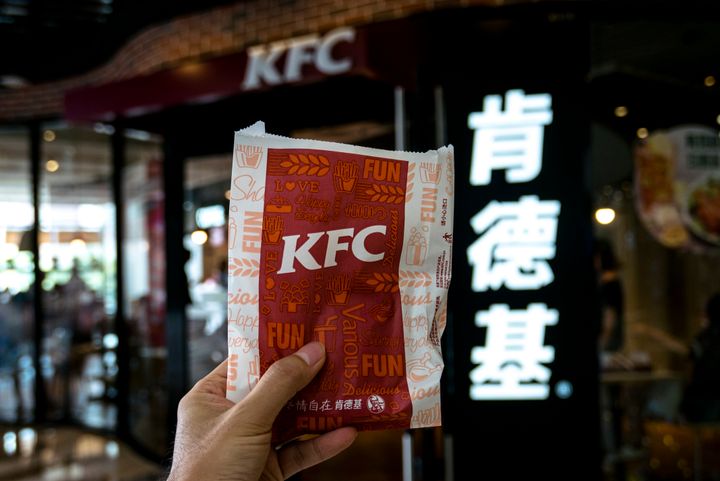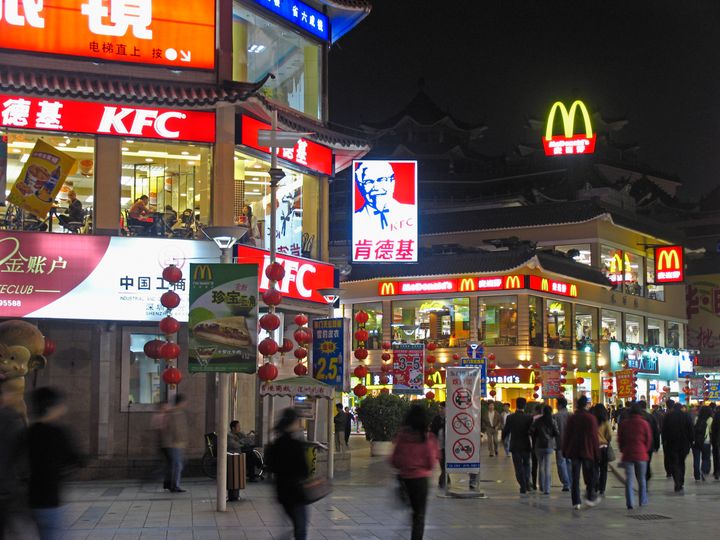
When KFC opened its first restaurant in Beijing in 1987, people from all over the city flocked there for a taste of America. Foreign brands were still a novelty after the restrictions of the Mao Tse-tung era. Foreign fast-food restaurants represented quality and modernity, with KFC’s shiny three-story restaurant in China’s capital its largest in the world, seating up to 500 people.
A KFC meal was considered a luxury to most residents at the time, referred to as “fine dining.” Given that the average monthly wage in China was around 100 yuan ($15 in today’s money), most people ate at the restaurant (with its 6-yuan hamburgers and 2.5-yuan fried chicken meals) only on special occasions.
Today, KFC is the biggest fast-food brand in China, with more than 5,000 outlets. And over the last 30 years, KFC has been joined in China by Taco Bell, McDonald’s and Pizza Hut.
The scale of expansion has been immense. Fast-food businesses in China generate annual revenue of $125 billion. McDonald’s owns about 2,500 stores, with new outlets opening in China nearly every day. Meanwhile, homegrown competitors are piling in, led by Dicos, a fried chicken brand with 2,000 outlets.
But this fast-food love affair comes at a cost. It is a diet that has been linked by health academics to the rapid rise of diabetes and other non-communicable diseases. And its popularity appears to be slowing as a younger generation begins to make more healthful choices and demand better options.
In October, a study published the Healthy High Density Cities Lab at the University of Hong Kong, in collaboration with Oxford University, showed that people living near fast-food outlets have higher rates of Type 2 diabetes.
“We know it is unhealthy food, we know it adds calories, we know from other countries eating food that is disproportionately high in fats and salts is linked to obesity and hypertension,” said Barry Popkin, professor of global nutrition at the University of North Carolina. Popkin has worked closely with the Chinese government on public health and nutrition, coordinating the long-running China Health and Nutrition Survey.

The influence of junk food companies in China has been in the spotlight this month as Coca-Cola came under fire for lobbying Beijing’s health ministers in an effort to obtain tax cuts and avoid regulations, such as soda taxes.
“China is so big I think most Western [fast food] brands want a foothold there. Many of their CEOs have said this publicly and noted how important China is to their bottom lines. This has been part of the globalization project and has happened relatively quickly,” said Mia MacDonald, executive director of Brighter Green, a public policy organization.
Rapid urbanization and the greater availability and access to fast-food outlets are driving a shift in people’s diets, nutrition experts say. “There is an allure around these brands because they are from the West and represent something very clean and modern — something that was previously inaccessible when lives were more rural,” said Judy Bankman, a consultant and co-author of the Brighter Green report “Chronic Disease, Changing Diets and Sustainability.”
But the rise of diets heavy in salt, sugar and processed meat is linked to the increase of chronic illness across the country, said Popkin, a world expert best-known for coining the term “nutrition transition,” which describes the transition of developing countries from traditional diets high in cereal and fiber to western diets that are high in sugar, fat and animal-based products. That nutrition transition has been the case in China.
“It is happening in all of Asia, but China is the fastest because its income is growing the fastest and the government is really pushing consumption,” he said. But China has not done anything “to regulate the intake of fats, sodium, sugar in a serious way.”
Since 2014, China has had the highest number of obese adults (with the U.S. second), according to research from the medical journal The Lancet. Thirty percent of Chinese adults are overweight, and 12 percent are obese, according to China’s health watchdog, the Chinese Center for Disease Control and Prevention.
The country has more than 100 million diabetics — with Chinese adolescents ages 12 to 18 about four times more likely to develop diabetes than American teenagers. The higher risk factor in China is due to the rate of urbanization and economic development (increasing access to unhealthful food in cities), which contributes to diabetes. Genetic studies have suggested that inherited factors in the Chinese population may increase the risks too when compared with Caucasians.
Popkin said that unless swift action is taken to improve both disease prevention and treatment, the results could be grave for China. The intake of salty snacks, for example, has increased by a factor of 2.5 from 2005 to 2017, according to research at the University of North Carolina.
“Adult mortality will start to increase and offset the declines in mortality ... from cutting infectious diseases and undernutrition. [People in China] are slowly moving to a point where we are predicting that mortality and disability will go up. ... It is a serious issue that health professionals talk about but the government is not acting on,” Popkin said.
However, there are signs Chinese consumers may be starting to switch away from junk food. China’s fast-food sector is expected to show an annual expansion of just 2 percent in 2019, its slowest since 2016, according to Bloomberg.
In the pockets of affluent districts in Shanghai and Beijing, there are a growing number of organic cafes and farmers markets springing up in fashionable malls.
There is increasing demand for more healthful food, said Cecilia Zhou, chief project officer at the Good Food Fund, an organization based in Beijing that promotes nutritional health.
While China’s national health has suffered as a result of worsening diets, there are younger people, such as Zhou, who are demanding something different. “They care more about the environment and food ethics. That’s why vegan and or vegetarian lifestyles are becoming more popular among the younger generation,” she said.
For more content and to be part of the “This New World” community, follow our Facebook page.
HuffPost’s “This New World” series is funded by Partners for a New Economy and the Kendeda Fund. All content is editorially independent, with no influence or input from the foundations. If you have an idea or tip for the editorial series, send an email to thisnewworld@huffpost.com
